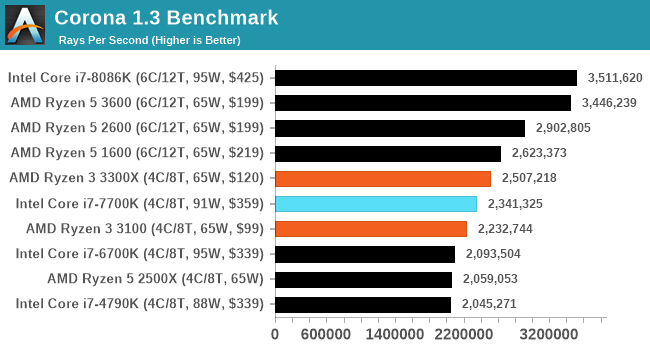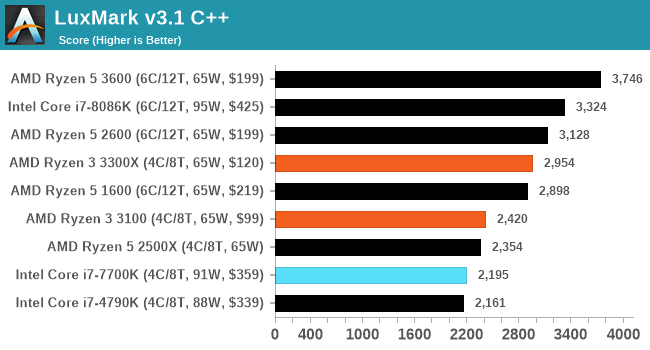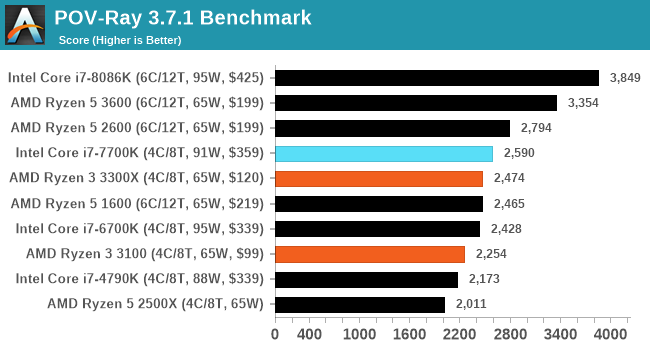The AMD Ryzen 3 3300X and 3100 CPU Review: A Budget Gaming Bonanza
by Dr. Ian Cutress on May 7, 2020 9:00 AM ESTCPU Performance: Rendering Tests
Rendering is often a key target for processor workloads, lending itself to a professional environment. It comes in different formats as well, from 3D rendering through rasterization, such as games, or by ray tracing, and invokes the ability of the software to manage meshes, textures, collisions, aliasing, physics (in animations), and discarding unnecessary work. Most renderers offer CPU code paths, while a few use GPUs and select environments use FPGAs or dedicated ASICs. For big studios however, CPUs are still the hardware of choice.
All of our benchmark results can also be found in our benchmark engine, Bench.
Corona 1.3: Performance Render
An advanced performance based renderer for software such as 3ds Max and Cinema 4D, the Corona benchmark renders a generated scene as a standard under its 1.3 software version. Normally the GUI implementation of the benchmark shows the scene being built, and allows the user to upload the result as a ‘time to complete’.
We got in contact with the developer who gave us a command line version of the benchmark that does a direct output of results. Rather than reporting time, we report the average number of rays per second across six runs, as the performance scaling of a result per unit time is typically visually easier to understand.
The Corona benchmark website can be found at https://corona-renderer.com/benchmark

LuxMark v3.1: LuxRender via Different Code Paths
As stated at the top, there are many different ways to process rendering data: CPU, GPU, Accelerator, and others. On top of that, there are many frameworks and APIs in which to program, depending on how the software will be used. LuxMark, a benchmark developed using the LuxRender engine, offers several different scenes and APIs.
In our test, we run the simple ‘Ball’ scene on both the C++ and OpenCL code paths, but in CPU mode. This scene starts with a rough render and slowly improves the quality over two minutes, giving a final result in what is essentially an average ‘kilorays per second’.

POV-Ray 3.7.1: Ray Tracing
The Persistence of Vision ray tracing engine is another well-known benchmarking tool, which was in a state of relative hibernation until AMD released its Zen processors, to which suddenly both Intel and AMD were submitting code to the main branch of the open source project. For our test, we use the built-in benchmark for all-cores, called from the command line.
POV-Ray can be downloaded from http://www.povray.org/












249 Comments
View All Comments
lightningz71 - Friday, May 8, 2020 - link
Because I was typing it on mobile, didn’t proofread before I hit submit, and the spell checker didn’t flag it as being wrong because it doesn’t know context.It’s my fault, my mistake, and I normally strive to do a better job with my spelling in general. Thank you for pointing out my mistake so that I can be more cognizant of my future errors.
Holliday75 - Saturday, May 9, 2020 - link
Now I feel like a d*ck for pointing it out.In all honesty just poking fun and genuinely curious because I see this mistake made daily all over the place. Facebook, comments, even articles by professional journalists and a work email or two. I find it curious when I know the people who speak American English natively and still make this mistake.
Spunjji - Monday, May 11, 2020 - link
Well, Autocorrect is one answer - and the other is the paradoxical relationship between the long "oo" sound in in lose and the shorter "oo" sound in loose. It's hard to argue that the spelling shouldn't be the other way around, although I have no doubt would still trip over it even then.notb - Thursday, May 7, 2020 - link
Idle power draw is atrocious. How can it be this high?It's not even that I'm worried about the unnecessary electricity use or noise (which could make an analogous APU a lot less interesting for HTPC and NAS).
I'm just really shocked by interconnect using 16W when the cores it joins are hardly doing anything.
Does anyone know what is I/O die doing? Is there a 10W ASIC mining bitcoin or what?
eastcoast_pete - Thursday, May 7, 2020 - link
Hush! You're spilling the beans here (:Actually, if AMD had a highly efficient ASIC mining chip with good hash rates, I'd consider buying some. Same goes for Intel.
notb - Friday, May 8, 2020 - link
Actually Intel is a major FPGA maker, so you can get one of those. It's not that hard to find an open-source coin miner (even on GitHub).The comment stand though. I googled a bit and there's no clear explanation for the high idle uncore.
And 8-core mobile Zen2 chips use maybe 3W in idle. It's not like their IF is a lot slower or has less to do.
This makes me wonder if we're even going to see desktop/server 35W chips? Not to mention it would be nice if they offered TDP down of 25W...
Suddenly, I'm a lot less interested in an AMD-powered home server or NAS (and BTW: EPYC embedded lineup is still Zen-only).
kepstin - Friday, May 8, 2020 - link
If they do make desktop 35W chips, they'll probably be based on the integrated APU die. I suspect the increased idle power is due either to off-die IF link to the IO chiplet needing more power than IF within a die, or perhaps the (14nm) IO chiplet itself having higher power usage.notb - Friday, May 8, 2020 - link
I'm OK with this kind of uncore under load (it's how Zen works).And I don't really mind high idle in workstation CPUs. It's an acceptable compromise.
I just assumed that they'll adjust this for low-core CPUs, since these often go into home PCs used casually - spending a lot of time at idle / low. And under a cheap, slim cooler there will be a difference between 5 and 16W.
AMD will have to fix this in the APUs if they want to take on low-power segments (NAS, HTPC, tiny office desktops).
AFAIK Zen2 APUs will use the chiplet layout, not monolithic approach from the mobile offer. Hence, OEMs will probably use mobile chips anyway. DIY customers may have a problem.
Holliday75 - Saturday, May 9, 2020 - link
We've seen updates addressing issues with previous Zen CPU's. Possible it could be a miss on their part of just didn't have the time to tweak it before release.Namisecond - Thursday, May 7, 2020 - link
Thanks for detailing the two new AMD CPUs. Any news on the new desktop APUs though? I'm hearing rumors of up to 8 cores but the GPUs on them will be worse than the previous generation.